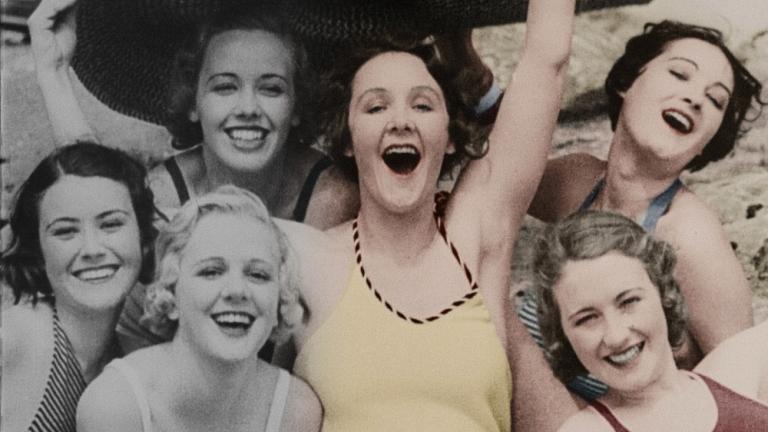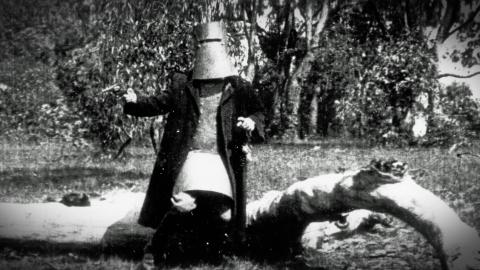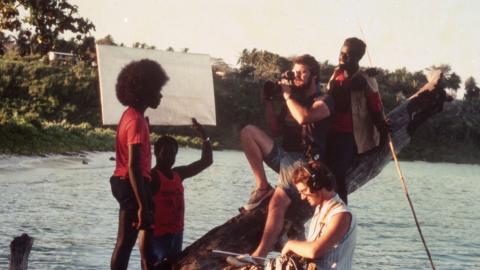

Australia in Colour
Australia in Colour – landmark SBS series with NFSA content
The NFSA provided nearly three-quarters of the footage used in the groundbreaking four-part series Australia in Colour, screening on SBS in March.
This documentary series produced by Stranger Than Fiction Films tells the history of Australia via a unique collection of cinematic moments brought to life for the first time in stunning colour.
Narrated by Hugo Weaving, many of these moments come from the NFSA collection – including newsreels, parts of feature films (such as The Story of the Kelly Gang, 1906), the Film Australia Collection, documentaries, home movies and advertisements.
In all, Australia in Colour uses 144 minutes of material drawn from 323 NFSA titles – about 70% of the whole series.
Choosing the right colours
Art director Samuel François-Steininger developed many of the processes, skills and techniques for colourising Australia in Colour when working on the US series America in Color.
‘We brought an approach to colourisation that aimed to restore the film to the closest original state of the scene. The colourisation was not made to be only aesthetically pleasing or believable, but above all historically accurate.’
When colourising the footage of a significant historical event, the filmmakers might go to weather records to find out the temperature and the extent of the cloud cover at a particular location on a particular date. When working on crowd scenes they might study the fashions and the dominant colours of the season. Books, still photographs, interviews with historians and eyewitness accounts are among other resources used.

Ned Kelly in his last stand at Glenrowan as depicted in the 1906 feature film, The Story of the Kelly Gang.
Click image to open

Victory in the Pacific street celebrations in Elizabeth Street, Sydney, in August 1945 marking the end of World War Two.
Click image to open

Group of 1920s women under a broad hat enjoy the beach life.
Click image to open

Legendary cricketer, Don Bradman, interviewed at the Sydney Cricket Ground in 1931.
Click image to open

A procession of university students advocating women's right to vote proceeds along a Sydney city street, 1913.
Click image to open

Colourful floats are part of the Sydney pageant marking the 150th anniversary of the First Fleet's landing in 1938.
Click image to open
For the iconic footage of Frank McAlary dancing along Sydney’s George Street during a tickertape parade on 15 August 1945, celebrating the end of the Second World War, the NFSA supplied a bundle of letters and newspaper clippings (see image in photo gallery above; clear on image for larger view). They came from a woman who was in the footage with McAlary – arm in arm with her aunt.
The letters contained a lot of invaluable details about the day: the celebrations, the fabric of McAlary’s clothes, the colour of his clothes and shoes, and the fact that he had red hair (see main image above).
World first
One of the first sequences in Australia in Colour shows a man roller-skating in Sydney’s Prince Alfred Park in September 1896. The footage is believed to be the oldest surviving moving image of Australia. A record of the running of the Melbourne Cup from later that year also exists and is included.
Both sequences were filmed under the patronage of Auguste and Louis Lumière, French siblings generally regarded as the world’s first filmmakers. Producer Jo-anne McGowan believes it is the first time permission has been granted to colourise Lumière material.

My favourite piece of footage is the very first one … the larrikin cigar-puffing roller- skating entertainer. Both of its day, yet somehow essentially timeless
Finding new details
The NFSA is accustomed to supplying ultra-high definition (UHD) material for film and television productions but rarely are those productions made entirely from archival footage or of the scale of Australia in Colour.
Craig Dingwall, Digital Film Preservation Colourist at the NFSA, scanned 230 of the 323 titles. Each title had to be scanned in its entirety, even though the filmmakers were only using a fraction.
‘We created ultra-high definition digital scans in 4K, which is twice the resolution of what you see in most cinemas now,’ said Craig. ‘We’ve been able to see so much more detail on street signs and car number plates, and we’ve been able to recognise faces and places.’
Newfound details about each title were added to the NFSA’s catalogue database throughout the process.
Before being scanned the material had to be retrieved from the vault, prepared, checked and cleaned. After being scanned it was graded to ensure the footage looked consistent. This might include lightening shadows or making adjustments because of different exposure levels between one piece of film and another.
Choosing the most suitable components, the ones that will result in the best quality scan, is a painstaking process that requires checking and comparing the condition of all sources available. The earliest generation copy is preferred but in many cases, image and sound were copied from separate items.
The NFSA also had to check and recheck copyright clearances. All the licensing and scanning work will benefit not only the NFSA but other filmmakers and content producers.
A special screening of Australia in Colour: Episode One on the big screen takes place at the NFSA’s Arc cinema in Canberra on Saturday 11 May at 1pm, followed by a discussion with producer Jo-Anne McGowan and from the NFSA: General Manager, Collections and Access, Meg Labrum, Craig Dingwall and Collection Reference Coordinator Simon Drake.
The four episodes of Australia in Colour premiere on SBS on Wednesdays at 8.30pm throughout March in 2019 and are also available on SBS on Demand.
The National Film and Sound Archive of Australia acknowledges Australia’s Aboriginal and Torres Strait Islander peoples as the Traditional Custodians of the land on which we work and live and gives respect to their Elders both past and present.


